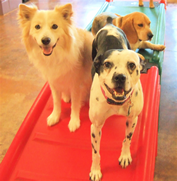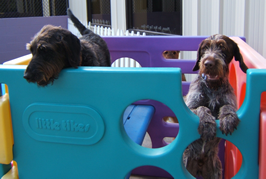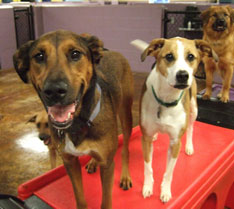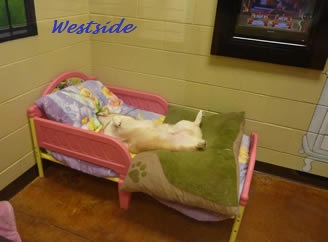Doggie Daycare Benefits
Dogs as pack members
Let's start by discussing the philosophy behind why doggie daycares originated and why they are so important. Everyone may know that dogs are pack animals, but many people don't know what that means. Dogs are born knowing how to be dogs. They instinctually know how to communicate with each other, what a play bow means, how to play, how to interpret another dog's mood, etc. When I hear a customer say, "My dog doesn't even know she's a dog," it makes me smile. Your dog not only knows she's a dog, but expects you to communicate and behave like one too. They desire interaction with their own species. Human mommies and daddies are great, but no matter how hard we try, we can not replace our dogs' need for canine companionship. This is why I highly recommend owning more than one dog. If owning more than one dog is not an option, dog parks and daycares are great alternatives for providing much needed dog socialization.
While in this "pack," a hierachy quickly establishes. Within minutes, dogs distinguish who the alpha is. Alpha doesn't imply aggression; it simply means dominance. As humans, we can more easily substitute the word confidence in place of dominance. Anyone with a feisty dachshund can tell you that size, sex, color, breed nor age has anything to do with who becomes the leader. Within the pack, dogs play, submit to others, exert their dominance (even during play), try to "romance" and even discipline (give an appropriate behavior to show disapproval of another dog's behavior) their fellow canines. An example of dog discipline can be seen when a rowdy puppy jumps in an adult dog's face, only to be greeted with a growl to let the puppy know, "I don't want to play." The puppy signifies that he understands this message by either rolling over to expose his belly or simply moving away, actually "shaking it off" as a way to diffuse stress. With a few exceptions (e.g., two unneutered males vieing for a female dog's attention, or a dog guarding its food from other dogs), approximately 80% of dog "fights" do not lead to injuries. The goal of each dog is to communicate a message, NOT to inflict injury.
Doggie Daycare vs. the Dog Park
The difference between doggie daycares vs. dog parks/group of loose dogs is a controlled environment. Here at Pawtropolis, the staff member assumes the position of "alpha." The dogs in day care quickly learn to recognize staff members as the leaders of the pack. We, as staff, are able to formulate the best playgroups, match dogs of similar sizes, similar play styles, etc. Staff also step in to help the aforementioned puppy (aka, "doggie nerds" as we like to call them) appropriately interact with his adult peers. In addition, we help dogs understand when another dog is not in the mood to play, redirecting their attention and/or matching them with other equally playful dogs. Furthermore, we have the luxury of selecting only those dogs suited for doggie daycare as well as keeping all unneutered males over 7 months old out of the playgroups. Lastly, staff keep all food out of the communal areas to curtail food aggression among the dogs.
Steps to Ensure Safety
As evidenced by trained staff and close supervision of the dog playgroups, you can easily see how doggie daycares are safer than un-manned dog parks. Now, let's take a moment to discuss the extra steps Pawtropolis takes to ensure the safest environment possible for your dog(s).
-Playgroup Compatibility Evaluation
During our evaluation, front-of-house staff take time to discuss with the dog's owner any potential problems/concerns. Our next step is to introduce the new dog -- one at a time -- to the other dogs in daycare. We are very selective about the dogs we introduce first, using those that attend daycare frequently and do well amidst a variety of personalities. As the dog acclimates to his new surroundings, staff keep a watchful eye for any signs of aggression. Posturing is to be expected. A new dog may emit a nervous growl to let the other dogs know that he needs some space. Overt aggression and lunging at other dogs, however, is not tolerated at Pawtropolis.
-Similar sizes
Having an animal behavior background and training, I can say, with assurance, that dogs of mixed sizes can do well together. I know many Jack Russells who prefer the company and play style of the big dogs any day. Mixing the dog groups used to be the norm at Pawtropolis. In the past, staff would often match dogs according to their temperament/playstyle rather than just by their size.
Though dogs don't care about size, due to the higher chance of a smaller dog being accidentially injured by a big dog playing, we at Pawtropolis are now compelled to to err on the side of caution by not allowing the mixture of different size dogs.
-Behavior Reports and Log Books
Even after a dog has been through and passed our evaluation, our monitoring doesn't stop there. Employees keep a very thorough log of any behavioral problems we see from a dog. We note any scuffles, rough play, time-outs, or inappropriate behaviors. Scratches or abnormalties found on any dog are detailed as well. If a dog's behavior becomes a safety concern, that dog is therein restricted to alone play away from the other dogs. Many owners may not want to hear that their "baby" has misbehaved; however, it is Pawtropolis policy to keep owners aware of any problem behaviors we observe from their dogs.
-Monitoring Playgroups and Keeping Play at a Safe Level
Dog playtime comes in cycles of play: rest -- play -- rest. You may notice groups wrestling around, or at other times sleeping, or lounging around. It just depends on which part of the play cycle they are in. Most of the dogs that come to Pawtropolis love to play and can become quite rowdy. Staff make a concerted effort to ensure that play/excitement level in each play group remains under control. We teach the dogs to observe certain rules and boundaries, e.g., not jumping on the gates and fences, not barking at each other through the fence, not jumping on people, etc. Respecting these rules ultimately ensures that all of the dogs at Pawtropolis will be happy and safe.
-Extensive Employee Training
All new Pawtropolis employees must complete their first level of training through our Certified Training Program. They learn about pack behavior, play behavior, proper dog supervision, effective discipline techniques, etc. They are taught how to respond in cases of emergencies or natural disasters. Even after their initial training is complete, staff are encouraged to advance their knowledge and learning . Many of our employees have even been certified as Pet Care Technicians through the American Boarding and Kennels Association (ABKA.). Educational staff meetings are also held every month and a half to update staff on dog and cat related topics and/or learn about additional aspects of animal care and behavior.
Worst Case Scenario
So, the question on some people's minds regarding doggie day care is: "Can my dog be injured?" The best analogy to describe how safe doggie daycare really is would be to compare it to letting your child play on a playground. Your child can fall off the slide and break a leg, catch a cold from another kid (playgrounds don't require vaccine records like we do), run into a bully, get a scratch from rough housing with the boys, etc. Most people wouldn't think twice regarding such contingencies. Unless you keep your child in a padded room (or a crate as in your dog's case), you have to be ready and responsible for accidents like these. You know how great the benefits are of letting your child play and have a good time with other children. So, why does it seem so different when it happens to dogs? Well, dogs don't play with hands; they play with paws, claws and teeth. If your dog is a playgroup member, you may occasionally see a scratch or two. However it is rare for any major altercations to occur. The few injuries that do happen are actually the result of play.
Safer than your own backyard
Let's take a look at how SAFE doggie daycare actually is. Since our grand opening in December 2001, we've had over 7,000 animals attend doggie daycare or board at Pawtropolis. We average about 60-100 dogs per day for daycare alone. That is a staggering amount of dogs enjoying our daycare every day. However, we may have an injury once month. When I say injury I'm talking about a scratch or a small puncture. This safety rating cannot be said from most companies, not to mention a company that cares for animals.
Pawtropolis has always and will always pride ourselves in providing the highest level of care. Here, your dogs will not only be safe and well cared for, they will also have fun! Your dog pulling you in the Pawtropolis door is testament to that! We love our customers--both human and canine. Since having an open relationship with everyone is important to us, please don't hesitate to ask any questions about our policies or procedures at any time.
Home Away From Home
One of the main reasons boarding your pet is normally a stressful experience for both the pet and owner is the dog's lack of familarity with his or her surroundings and care takers. By allowing your dog to participate in our doggie daycare program regularly you build a second home away from home.

The best thing for your dog is to have more than one place that they feel comfortable. Even pet owners who don't need doggie daycare on a regular basis should try to bring their dog at least a couple times a month. This keeps the dog familar with the staff, the other dogs in playgroups and our facility. This way when they board they are very used to the routine and much less likely to experience anything negative related to stress.


Contact Us
Eastside:706-850-8744 Westside: 706-227-7887


